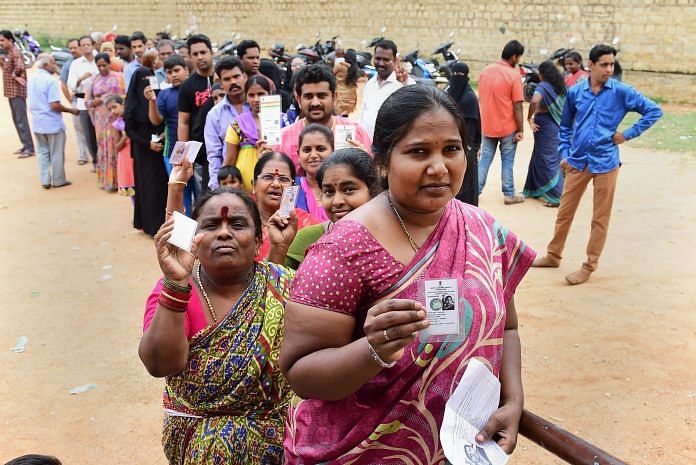It appears that the initial advantages that the Congress party had have not meant big electoral gains for it.
Kannada television news channels aired promos for exit poll discussions all day on the eve of the Karnataka assembly elections. The curiosity though could never dispense with mistrust: the exit polls have been so widely off in recent times. Blatant partisanship and flawed survey methods have played a part here.
Little surprise then that the three main political parties in the Karnataka elections have dismissed the exit poll results. All of them feel certain of getting a majority on their own. Among the eight exit polls, six have given a clear lead to the BJP and two to the Congress. The JD(S) comes third in all eight.

Clearly, the poll estimates vary highly. A few poll agencies at least have not worked with sound survey methods. And the reliability of any one survey cannot also be ascertained at this time.
A glance at the best poll result scenarios for each party, however, helps make a few good guesses and raise a few sound questions.
One easy inference is that no party enjoys overwhelming support across the state. In other words, a “wave” is missing this time. Neither an anti-incumbent one nor a pro-ruling party one.
Since the most optimistic seat projection for the Congress gives it only half a dozen more seats above the halfway mark needed to get a majority, it appears that the initial advantages that the party had in this campaign, i.e. the support it enjoyed for its welfarist measures, its embrace of the Kannada cause, its support for the separate religion status for the Lingayat, have not meant big electoral gains for it. Or, were the gains from these factors offset by mistakes in ticket distribution, in-party differences, or unforeseen local challenges?
Party insiders admit that their campaign lost momentum from mid-April onwards when their chief campaigner, Siddaramaiah, decided to contest from Chamundeshwari instead of from Varuna where he had won last time. This decision saw him put much effort and time to confirm his chances in his constituency and then eventually decide to contest in a second constituency. The party’s campaign, they add, never recovered the earlier energy and had to go on the defensive after Modi’s visit began in early May.
The efforts of the BJP have shifted things in its favour, but not dramatically. For instance, the same poll agency that gave the BJP the highest estimate of 114 seats in the exit poll had given it 108 seats in the pre-election poll. In another instance, VMR-Times Now which had given the BJP 89 seats in the pre-election poll has given it 94 seats in the exit poll. While these seat estimates are more than double the BJP’s present seat share of 40 in the Karnataka state assembly, the return of the breakaway factions of KJP and BSR could account for much of the increase.
A few other facts can be guessed. Modi’s campaign speeches across the state in the few days preceding the election may have cheered party workers, but it appears not have to been able to pull off last minute miracles. Furthermore, BJP’s relentless ad campaigns in the newspapers, television and radio, which was easily the most expensive election campaign in the state, seem not to have achieved all that much. Finally, the micro-efforts of its party workers, which would have outmatched those of their counterparts in the other parties, might not have amounted to much.
The highest seat estimate for the JD(S) found in the exit polls was 44 (Jan ki Baat-Republic TV), which shows only a minor increase in the performance of the JD(S).
It had won 40 seats in the 2013 assembly elections (20 from southern Karnataka and 20 from elsewhere). Have any seat gains from the consolidation of Vokkaliga votes behind the JD(S) in this election been offset by the shift of Muslim votes away from it due to the Congress’ accusation of it being in tacit alliance with the BJP? Has the party’s consistent promise of the waiver of all farm loans helped retain its present number of seats?
Something that analysts are certain of, and for which the exit polls have not conveyed a sense for, is that local factors have proven decisive in most constituencies: anti-incumbency towards sitting MLAs, bitterness over candidate selection, inner-party rivalry, the money might of the candidates and their parties, the role of rebel candidates, the caste and religious identities of the candidates.
In this scenario, even the exit poll that might prove in retrospect to have been the most accurate will have concealed more than what it has revealed.
Unlike pre-poll surveys, the exit polls are harmless since the votes have already been cast. But they have their effects.
As the exit poll results rolled out Saturday, Rahul Gandhi tweeted asking Siddaramaiah to prepare for the swearing in ceremony. The following day, the latter conveyed his openness to any decision of the party high command to choose a Dalit CM in the next government. The shift, in all probability, is due to the exit polls, which have not held out a big win for the party, making the Congress explore a coalition option with the JD(S).
The author is a Professor of Sociology at the Azim Premji University in Bengaluru.






